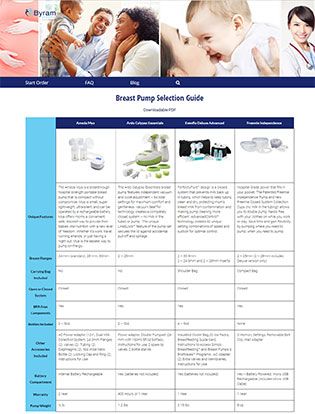7 Causes of Blood in Pumped Breast Milk
Breast pumping is a wonderful way to make sure that your baby has access to breast milk, even when you can’t be there to feed them. It can also help alleviate symptoms of engorgement and reduce the risk of a clogged duct. Although you might not pay too much attention to the breast milk coming out during pumping sessions, seeing small deviations in color can be quite alarming. This is especially true when your breast milk appears red or pink. Traces of blood in your breast milk can be a little scary, but it’s not always a cause for concern. To help you better understanding what’s happening and how to address it, consider the following causes of blood in pumped breast milk.
Should You Throw Away Breast Milk with Blood?
First and foremost, it’s important to know that breast milk with traces of blood in it is safe for your baby—usually. Instances where it might not be safe are if you have a blood infection or illness, such as hepatitis or HIV. You can talk to your doctor to get a better understanding of what’s causing the blood in your breast milk, run any tests you may want to get some peace of mind, and then take comfort in your ability to nourish your baby regardless of what’s happen.
Breast milk that has traces of blood in it may, however, change the taste for your baby. This could lead to nursing aversions or hesitations when nursing. Blood may also increase the amount of spit-up that your baby experiences. Although rare, if traces of blood make your baby vomit, it’s important to take them to your pediatrician or an emergency care room immediately. Vomiting during early life can be dangerous, so seek medical assistance immediately.
Blood in pumped breast milk could also cause blood to appear in your baby’s stool. Even if you think this is caused by the blood in your breast milk, it’s still important to see your baby’s pediatrician to be sure. Blood in stool can be a serious symptom of other complications, so it’s best to rule it out just in case.
7 Causes of Blood in Breast Milk
Blood in breast milk isn’t always easy to recognize. It may go completely unnoticed due to the amount of blood versus breast milk, or it could cause breast milk to take on a strawberry pink appearance. However, blood in breast milk can also cause colors like black, olive green, or even a brownish color. If you notice any indication that something’s not right, the best thing to do is to see your doctor. In the meantime, try not to stress. There are several reasons that blood may be present in your breast milk and most of them are nothing to worry about.
-
Food or Drink
Have you ever eaten a lot of beets and noticed a change in your urine or stool color? The same thing can actually happen with breast milk. Foods that are rich in reds can make it look like there’s blood in your breast milk, even if there isn’t any present. This coloring should pass as soon as your body digests whatever you’ve eaten.
-
Cracked Nipples
One of the most common reasons for blood in breast milk is due to cracked nipples. This is a normal complication of breastfeeding that’s usually caused by a poor latch. The inefficient hold on your breast can cause irritation, which then leads to cracking or discomfort. When not hydrated enough, the cracks can eventually break open and bleed.
At the first sign of cracked nipples, it’s important to try and fix the underlying issue. You could try a different breastfeeding position to see if it will help your baby create a stronger latch or work with a lactation consultant to better understand what’s going on. You can also alleviate any pain caused by cracked nipples and reduce the risk of bleeding by applying a breastfeeding-friendly moisturizer or cream. However, without addressing a poor latch, cracked nipples will continue to happen.

-
Broken Capillaries
Another common cause of blood in breast milk is due to broken capillaries. This is usually caused by the incorrect use of a breast pump, where the suction is too strong and causes damage to the blood vessels. This trauma isn’t considered normal and should be addressed to reduce the risk of ongoing issues. The best way to do this is to make sure that you read the manufacturer’s instructions on using your breast pump completely and avoid using the highest settings for suction. You can still expel milk on low pump settings, you just need to experiment with the letdown phase and try to be patient. If you continue experiencing symptoms of broken capillaries, talk to your doctor or a lactation consultant for recommendations.
-
Rusty Pipe Syndrome
Vascular engorgement, which is also called rusty pipe syndrome, is a side effect from the increased blood flow to your breasts during the initial milk production. This is a normal part of the process, and tends to subside in a few days. Vascular engorgement causes blood to seep into your milk, which can result in a brown or orangish color that’s similar to the appearance of rust. This is why it’s often referred to as rusty pipe syndrome. Although it looks alarming, it’s completely safe and can still be given to your baby.
-
Mastitis
Breast engorgement will happen to most mothers at some point, especially as they’re navigating the initial changes with supply and demand. Engorgement can be treated with home remedies, but if it continues to get worse it could be an indication of mastitis. Mastitis is when the breast becomes infected, which can produce blood in breast milk. If you think you’re experiencing mastitis, it’s important to see your doctor as soon as possible for treatment. Common symptoms include swelling, redness, and pain that does not get better. You may also have a fever or present signs of an infection such as nausea, fatigue, or dizziness.
-
Benign Intraductal Papilloma
Benign intraductal papilloma is a term that’s used to describe small, benign tumors that are growing in the lining of your milk ducts. Although this can sound alarming, they’re usually pretty harmless in and of themselves. However, a benign intraductal papilloma can increase your risk factor for breast cancer, so it’s important to stay vigilant about preventative care and screenings with your doctor. If you have a benign intraductal papilloma, you’ll likely notice small bumps in your breast or bleeding directly from the nipple regardless of hydration.
-
Breast Cancer
Although most instances of blood in breast milk are nothing to be concerned of, there are rare occurrences where it could be an early sign of breast cancer. If you notice any bleeding that’s not related to any of the above issues, see your doctor. It’s likely something else, but it’s always better to be sure, especially in regard to early detection of cancer.
Although most of the common reasons for blood in the breast milk are normal and will dissipate on their own, seeing your doctor can help give you peace of mind and rule out more serious complications such as mastitis or breast cancer. If you’re not sure what’s causing the bleeding, schedule an appointment as soon as possible especially if it’s persistent.
How to Address Blood in Breast Milk
Talking to your doctor is the first step in determining the underlying cause of the blood in your breast milk. If you have cracked or bleeding nipples, this could be an obvious cause. However, other potential causes may not be as apparent. In addition to seeing your doctor, you may want to work with a lactation consultant to ensure that your baby has the strongest latch possible, which can help reduce damage to the nipples. Although it may seem counterintuitive, you shouldn’t stop breastfeeding or breast pumping just because there are traces of blood present. Even if you have a blood infection or illness, continue to pump to avoid blocked ducts or painful engorgement while you and your doctor determine the cause and treatment.
Breast pumping is a great way to supplement feedings and build your milk supply. To help you provide your baby with the essential nutrients they need during development, Byram Healthcare has a wide selection of insurance covered breast pumps. To get started with our easy, three-step ordering process, visit our breast pump selection page today.





